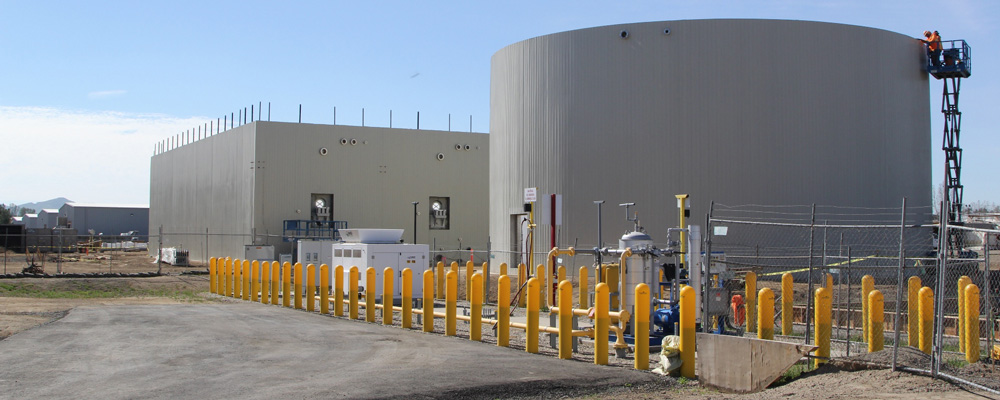
The Next Renewable Energy Resource for America
by Paul Relis
It has been a long time coming; a new renewable energy resource for America is at last emerging.
Food waste we clean out from our refrigerators, the discards from supermarkets/ farmers markets, the green materials and leaves from our homes and gardens, the residues from food processing plants, dairy farm manures, and the non utilized gas produced from waste water facilities, all of these largely wasted resources are beginning to be used to produce renewable natural gas to power heavy duty trucks and buses, generate green electricity and make soil products for a wide range of applications.
The technology to accomplish these ends is called Anaerobic Digestion (AD). AD is essentially a mechanical stomach that decomposes organic materials in a non-oxygen environment, thus the term“anaerobic.” The product of this decomposition is called biogas. The raw biogas that is produced needs to be cleaned up so that it is nearly pure methane, free of C02. Once cleaned the biologically produced gas can be used to make green fuel or generate electricity.
bA biogas revolution has begun in scattered parts of the country, but it’s in California where the first large scale applications of this previously untapped renewable energy resource are poised to develop quickly. According to the Bioenergy Association of California 2.4 billion gallons of transportation fuels, enough to satisfy 10% of the state’s total demand can be produced from the organic wastes not being exploited as an energy resource. The fuel value from this bioenergy source is enough to replace three quarters of the diesel used by motor vehicles in California. and could generate more than 1,700 megawatts of power while reducing greenhouse gases by 25 million tons per year.
Removal of organic waste from our landfills will eliminate methane gas releases that are between 20 to 30 times more potent than C02 in the atmosphere according to scientists. Because methane gas is a short-lived but powerful contributor to climate change, recycling organic waste through anaerobic digestion can have the most significant near-term impacts on reducing climate change. Biogas, cleaned up to a fuel grade gas is a carbon negative fuel, the cleanest there is at the present time. Existing natural gas trucks and buses can use this fuel now, because their engines can run on this gas as effectively as fossil-sourced natural gas. The engines don’t know the difference, as long as the fuel is 96% or higher in methane content.
Compared with the well-established solar and wind, renewable energy technologies, AD has one unique dimension that solar and wind doesn’t, it produces energy around the clock. When night falls for solar, or its cloudy, or there are no winds to move the turbines , AD plants produce power and fuels night and day, rain or shine.
In addition to the multiple renewable energy benefits of biogas are the soil products that are produced as a result of digesting organic waste and converting it to renewable energy. Over 80% of organic materials that undergo anaerobic digestion remain available as a nutrient resource that can be composted or land applied. As long as the incoming materials are free of contaminants like plastic, and that the AD process itself or in combination with composting, eliminates pathogens, soil products derived from the AD process become a major new source of organic nutrients along with their water conserving properties.
Given the multiplicity of AD benefits an obvious question is why hasn’t this technology been widely adopted in the U.S. and environmentally progressive states like California? The answer is simple. Cheap landfill has been the major stumbling block. Organic discards can be tossed into a California landfill for as little as $30 per ton. AD systems cost about $70 per ton by contrast-a fact that has made investment in AD prohibitive up until now.
But these cost metrics are changing. Landfills are now recognized as a major source of green house gas emissions and as such, they are now the target of emission reductions efforts by the California Air Resources Board, CalRecycle and other state and local agencies that are tasked with reducing GHG emissions. The California Air Resources Board , charged with implementing AB 32, California’s ambitious climate change law that seeks to reduce C02 emissions to 1990 levels by 2020 has targeted landfills as one of the principal culprits in methane gas emissions. Various incentives, including grants as well as regulations to reduce these emissions are beginning to fuel investments in AD development. Moreover, in 2014 California passed two laws AB 1594, and AB 1826, that will stem greenhouse gas emissions and increase the state’s recycling rate to at least 75%. When fully implemented in 2020 they will effectively phase out land filling organic waste.
California based companies like CR&R in Southern California and Zero Waste in Northern California have, or will soon have, AD facilities capable of processing organic waste in some of the most populated parts of the state including San Jose, Los Angeles and cities like Costa Mesa and Temecula. Smaller communities such as Monterey, Davis and Marin already have AD facilities.
In the case of CR&R’s AD facility much of the financing to build it is provided by the municipalities that the company serves under long-term service contracts. Modest rate increases of less than 10%, or about $2.00 per household per month, have already been approved by city councils. The relatively low rate increases are made possible by the design efficiency and scale of the AD and related technologies that CR&R has deployed , and grant funding from cap and trade dollars and renewable fuel incentives such as the federal renewable fuel standard (RFS) and California’s Low Carbon Fuel Standard (LCFS). City Councils have elected to go with AD technology because of the new organic diversion mandates imposed by the state and that AD technology enables these communities to have the emission emitting waste and recycling trucks running through their neighborhoods. If you’ve seen the movie fantasy, “Back to the Future” where bananas power a flying machine, AD fuel-producing facilities do just that.
With about 10 million tons of organic waste land filled each year in California, the potential exists to build at least 80 AD facilities in California. Eighty facilities will generate about 4,000 construction jobs of a multi-year duration and produce about 80 million gallons of diesel gallon equivalent fuel, enough to power about 6,400 heavy duty trash trucks or buses. With new engine technology being introduced by Cummins Wesport in 2015 and 2016 respectively, greenhouse emissions from trucks running on AD generated fuel can become zero emission- emission level that the transportation sector will need to be to comply with federal clean air standards in Southern California. AD technology contributes the most at the least cost in the shortest timeframe towards realizing this goal.
The forerunners of this new renewable energy industry are out of the blocks. And just as recycling came about by initiatives taken at the local government followed by state law, we are witnessing the development of AD following a similar development path. Within the decade, I expect that AD will become the dominant means to manage organic wastes in California because it does what no other technology can do, it taps the energy latent in organic waste and makes it into renewable fuel and electricity while producing soil products from what remains. Locally generated, locally developed, and locally used, AD energy and soil products represent California’s next renewable energy and recycling revolution.
![By matthew.hickey (Flickr: [1]) [CC BY 2.0 (http://creativecommons.org/licenses/by/2.0) or CC BY 2.0 (http://creativecommons.org/licenses/by/2.0)], via Wikimedia Commons](https://paulrelis.com/wp-content/uploads/2016/04/Windmill_Field_outside_Palm_Springs_California-crop-200x200.jpg)



![Pollution Fines. Image By EARTHWORKS (Aliso Canyon leak well pad 1 Credit: Earthworks) [CC BY 2.0 (http://creativecommons.org/licenses/by/2.0)], via Wikimedia Commons](https://paulrelis.com/wp-content/uploads/2016/01/Aliso_Canyon_leak_well_pad_1_Credit-_Earthworks_23594167450-200x200.jpg)
After our conversation this afternoon, I found your site, and checked my schedule to see if I could hear you speak at the Lobero on the 12th. Unfortunately, I’m in rehearsals preparing for Carmina Burana with the SB Symphony/State Street Ballet/Santa Barbara Choral Society on the 17th-18th at the Granada. I’m interested in reading your book, ‘Out of the Wasteland, Stories from the Environmental Frontier’, as I feel we can vastly improve our environment, which in turn will certainly improve our health.